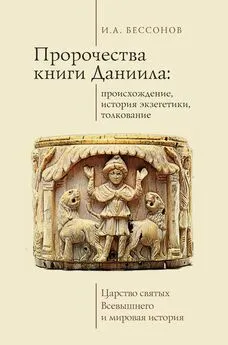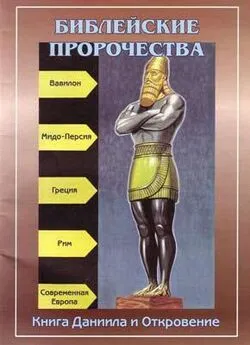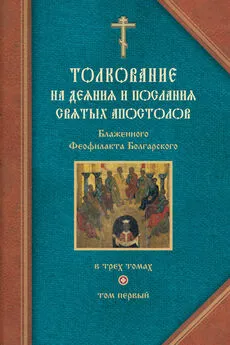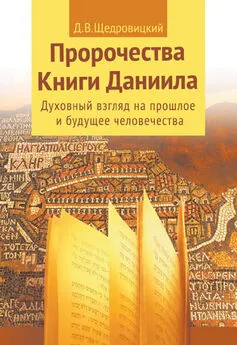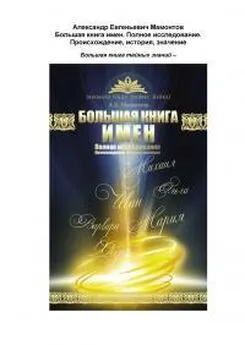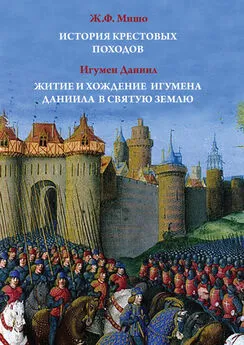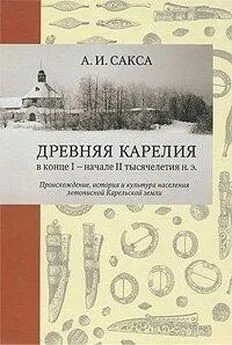Игорь Бессонов - Пророчества книги Даниила: происхождение, история экзегетики, толкование. Царство святых Всевышнего и мировая история
- Название:Пророчества книги Даниила: происхождение, история экзегетики, толкование. Царство святых Всевышнего и мировая история
- Автор:
- Жанр:
- Издательство:неизвестно
- Год:неизвестен
- ISBN:978-5-907189-66-9
- Рейтинг:
- Избранное:Добавить в избранное
-
Отзывы:
-
Ваша оценка:
Игорь Бессонов - Пророчества книги Даниила: происхождение, история экзегетики, толкование. Царство святых Всевышнего и мировая история краткое содержание
Пророчества книги Даниила: происхождение, история экзегетики, толкование. Царство святых Всевышнего и мировая история - читать онлайн бесплатно ознакомительный отрывок
Интервал:
Закладка:
115
Lebram Jürgen-Christian. Das Buch Daniel. Zürich, 1984. S. 21.
116
Albertz Rainer. Social Setting ofDaniel // The Book of Daniel. Composition and Reception. Vol. 1. Boston-Leiden, 2002. P. 179–183.
117
Вероятно, подобные мотивы действительно повлекли за собой создание греческого перевода указанного арамейского произведения; весьма вероятно, что тема обращения языческих царей к единобожию получила особое развитие именно в греческом переводе. Однако изначальное создание указанного произведения в Египте, предполагаемое Р. Альбертцем, представляется нам маловероятным. Обилие вавилонских традиций в 4–6 главах скорее позволяет нам заключить, что местом их создания была вавилонская диаспора.
118
Newsom Carol A. with Breed Brennan W. Daniel. A Commentary. Louisville, 2014. P. 21–23.
119
Ср. аналогичное мнение Л. Граббе: «Личность Даниила, вероятно, основана на фигуре нововавилонского и/или персидского периода, очевидно еврейского ясновидца или толкователя снов. То, что память о какой-то реальной исторической фигуре повлекла за собой возникновение историй настоящей книги вероятно еще и по той простой причине, что маловероятно, чтобы автор псевдоэпиграфического сочинения изобрел ранее неизвестную личность как главного героя историй» (Lester L. Grabbe. Op. cit. P. 230).
120
Месопотамские материалы Ахеменидского периода доносят до нас информацию о том, что многие местные евреи исполняли обязанности писцов-сепиру (двуязычные писцы-переводчики) (Zadok Ran. The Earliest Diaspora: Israelites and Judeans in Pre-Hellenistic Mesopotamia. Tel Aviv, 2002. P. 56).
121
Redditt Paul L. Daniel 1 1 and the Sociohistorical Setting of the Book ofDaniel // The Catholic Biblical Quarterly. Vol. 60, No. 3 (July 1998). P. 469.
122
См. Redditt Paul L. Op. cit. P. 465–467; Davies Philip R. The Scribal School ofDaniel // The Book ofDaniel. Composition and Reception. Vol. 1. Boston-Leiden, 2002. P. 255–256.
123
Albertz Rainer. A History ofIsraelite Religion in the Old Testament Period. Volume 2: From the Exile to the Maccabees. Louisville, 1994. P. 539.
124
Albertz Rainer. Social Setting of Daniel // The Book ofDaniel. Composition and Reception. Vol. 1. Boston-Leiden, 2002. P. 193–197.
125
Buchanan George Wesley. The Book of Daniel. Eugene, 2005; Boccacini Gabriele. The Solar Calendars of Daniel and Enoch // The Book of Daniel. Composition and Reception. Vol. 2. Boston-Leiden, 2002. P. 325; Й. Вейнберг. Введение в Танах. Писания. Иерусалим-Москва, 2005. С. 249–250.
126
Beckwith Roger T. The Old Testament Canon of the New Testament Church: and its Background in Early Judaism. Eugene, 2008. P. 356.
127
Bludau A. Die Alexandrinische Übersetzung des Buches Daniel und ihr Verhältnis zum massoretischen Texten. Freiburg Im Breisgau, 1897. S. 8.
128
Koch Klaus. Stages in the Canonization of the Book of Daniel // The Book of Daniel. Composition and Reception. Vol. 2. Boston-Leiden, 2002. P. 427.
129
Koch Klaus. Op. cit. P. 427–432; Collins, John J. Op. cit. P. 72–79.
130
Flint Peter W. The Daniel Tradition at Qumran // The Book of Daniel. Composition and Reception. Vol. 2. Boston-Leiden, 2002. P. 329–367.
131
См. Collins Adela Yabroo. The Influence of Daniel on the New Testament // John J. Collins. A Commentary on the Book of Daniel. Minneapolis, 1993. P. 90–123; Reception in Judaism and Christianity // The Book ofDaniel. Composition and Reception. Vol. II. Boston-Leiden, 2002. P. 421–572.
132
Childs Brevard S. Introduction to the Old Testament as Scripture. Philadelphia, 1979. P. 65– 66.
133
Koch Klaus. Is Daniel Also Among the Prophets? // Interpretation 39(2). 1985. P. 121.
134
Op. cit. P. 122.
135
Di Lella A. A. The textual history ofSeptuagint-Daniel and Theodotion-Daniel // The Book of Daniel. Composition and Reception. Vol. 2. Boston-Leiden, 2002. P. 596.
136
Di Lella A. A. Op. cit. P. 588.
137
Подробнее см. Childs Brevard S. Op. cit. P. 660–671.
138
Обсуждение этого вопроса см. в статье: Scheetz Jordan. Daniel’s Position in the Tanach, the LXX-Vulgate, and the Protestant Canon // Old Testament Essays 23/1 (2010). P. 178–193.
139
См., в частности классические работы, представляющие соответствующие концепции: Plöger Otto. Theocracy and Eschatology. Oxford, 1968; Rad Gerhard von. Theologie des Alten Testaments. Band 2. Die Theologie der Prophetischen Überlieferungen Israels. Berlin, 1964.
140
Hartman Louis F., A. Di Lella Alexander A. The Book ofDaniel. New York, 1980. P. 144– 145; Newsom Carol A. with Breed Brennan W. Op. cit. P. 70.
141
Newsom Carol A. with Breed Brennan W. Op. cit. P. 73-74.
142
Collins John J. Op. cit. P. 161.
143
Breasted James Henry. Ancient Records ofEgypt. The Nineteenth Dynasty. Urbana-Chicago, 2001. P. 245.
144
Цит. по Ancient Near Eastern Texts Relating to the Old Testament. Princeton, 1969. P. 313; сокращенный русский перевод см. Хрестоматия по истории Древнего Востока. Т.2. М., 1980. С. 21–22.
145
Подробнее см. McNamara Martin. Nabonidus and the Book of Daniel // Irish Theological Quarterly. Vol. 37. 1970. P. 131–149.
146
Bentzen Aage. Daniel. Tübingen, 1952; Hengel Martin. Judaism and Hellenism. Studies in their Encounter in Palestine during the Early Hellenistic Period. Eugene, 2003. P. 182.
147
West M.L. The East Face ofHelicon. West Asiatic Elements in Greek Poetry and Myth. Oxford, 2003; Feldman Louis H. Judaism and Hellenism Reconsidered. Leiden-Boston, 2006. P. 49– 50.
148
West M.L. Op. cit. P. 312–319.
149
В Бахман Яште говорится, что в это время будут править «дэвы со взъерошенными волосами», которых исследователи обычно отождествляют с македонцами (Eddy S.K. The King is Dead. Eastern Resistance to Hellenism, 334–31 B.C. Lincoln, 1961).
150
Collins John J. Op. cit. P. 166–170.
151
Впервые эта идея была выдвинута в работе Eerdmans B.D. Origin and Meaning of the Aramaic Part ofDaniel // Actes du XVIIIe congrès international des orientalistes (1932). P. 198– 202. Cм. также Davies Philip R. Daniel Chapter Two // The Journal of Theological Studies. Vol. 27. No 2. (October 1976). P. 392–401; Fröhlich Ida. Time and Times and Half a Time. Historical Consciousness in the Jewish Literature of the Persian and Hellenistic Eras. Sheffield, 1996. P. 1 1–48.
152
Fröhlich Ida. Op. cit. P. 28.
153
Op. cit. P. 26–27.
154
Fröhlich Ida. Op. cit. P. 28–34.
155
Seow C.L. From Mountain to Mountain: The Reign of God in Daniel 2 // A God So Near. Essays on Old Testament Theology. Winona Lake, 2003. P. 355–374.
156
Willis Amy C. Merrill. Dissonance and the Drama ofDivine Sovereignty in the Book of Daniel. New York-London, 2010. P. 37–38.
157
Kruschwitz Robert B. and Redditt Paul L. Nebuchadnezzar as the Head of Gold: Politics and History in the Theology of the Book of Daniel // Perspectives in Religious Studies, 24 (1997). P. 402.
158
Hartman Louis F., A. Di Lella Alexander. Op. cit. P. 143; Collins John J. Op. cit. P. 169; Newsom Carol A. with Breed Brennan W. Op. cit. P. 77–80.
159
Collins John J. Op. cit. P. 169. См. также Collins John J., The Apocalyptic Vision ofthe Book of Daniel. Missoula, 1977. P. 43–44.
160
Collins John J. A Commentary on the Book of Daniel. Minneapolis, 1993. P. 165.
161
Newsom Carol A. with Breed Brennan W. Op. cit. P. 77.
162
Collins John J. Op. cit. P. 171.
163
Синодальный перевод относит указания на Царство и всеобщее служение к Всевышнему; мы, в соответствии с мнением большинства современных комментаторов, относим их к «народу святых Всевышнего».
164
Gunkel H. Schöpfung und Chaos in Urzeit und Endzeit. Göttingen, 1895. S. 323–335.
165
Kraeling E.G.H. Some Babylonian and Iranian Mythology in the Seventh Chapter ofDaniel // Oriental Studies in honour ofCursetji Erachji Pavry. London, 1933. P. 228–31.
166
Heaton Eric William. The Book ofDaniel: Introduction and Commentary. London, 1956. P. 175.
167
Gardner Anne E. Daniel 7, 2–14: Another Look at its Mythic Pattern // Biblica. Vol. 82, No. 2 (2001). P. 244–252.
168
Bentzen Aage. King and Messiah. London, 1955. P. 74–75.
169
Emerton J.A. The Origin of the Son ofMan Imagery // The Journal of Theological Studies. 9 (1958). P. 239–240.
170
Collins John J. Op. cit. P. 287.
171
Mosca Paul G. Ugarit and Daniel 7: A Missing Link // Biblica. Vol. 67 (1986). P. 496–517.
172
Walton John. The Anzu Myth as Relevant Background for Daniel 7? // The Book of Daniel. Composition and Reception. Vol 1. Boston-Leiden, 2002. P. 69–90.
Читать дальшеИнтервал:
Закладка:
